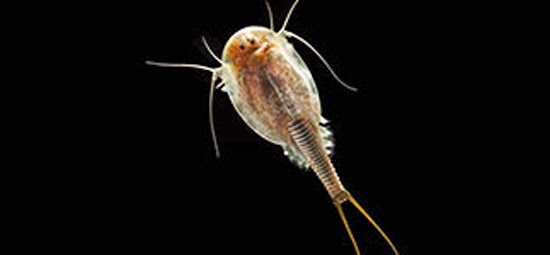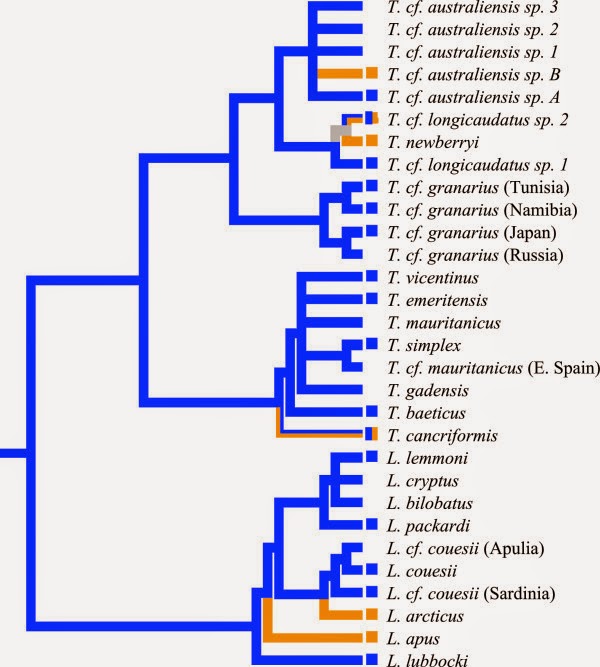
The term ‘living fossil’ was coined by Darwin and has since been applied to various species that appear not to have changed for millions of years. But when Africa Gómez and colleagues took a closer look at tadpole shrimps they concluded we should ditch the term for good.
In On the Origin of Species, Darwin used the term ‘living fossil’ informally, to convey how little lungfish and platypus had changed over millions of years. The label stuck, and is now commonly used to refer to species such as the coelacanth, the horseshoe crab and the ginkgo tree. Tadpole shrimps gained this epithet because ancient fossils of these small, pond-dwelling crustaceans appear almost indistinguishable from living species. Indeed, for over a century, tadpole shrimps (or more precisely the two genera Triops and Lepidurus which make up the order Notostraca) were regarded as a group that had diversified remarkably little since their origin over 300 million years ago – what we refer to as ‘morphological conservatism’.
Tadpole shrimps can be up to 10cm long when fully grown and have a broad oval carapace or shell at their front end and a long slender abdomen, giving them a tadpole-like shape. They live in temporary stands of water and their eggs can survive for a long time in dry sediment. In fact you may have encountered Triops ‘kits’ in shops – packets of eggs and food from which you can hatch your own small Triops as pets. The fact that these are often marketed as ‘from the age of the dinosaurs’ or ‘prehistoric sea monsters’ suggests the living fossil tag is firmly lodged in popular imagination.
But ‘living fossil’ has been taken to mean that evolution has stopped altogether. This was not what Darwin meant but in any case, is it true?
Tadpole shrimps may be morphologically conservative but a closer look reveals there’s a lot more to them, in particular the different ways they reproduce. Many populations are dioecious – they have equal frequencies of males and females – but others have mostly hermaphrodites and only a small proportion of males. This rare mechanism, known as androdioecy, is found in only a handful of animals. The hermaphrodites in androdioecious populations have sperm-producing lobes in their ovaries and they can both self-fertilise and mate with males.
Building on earlier work (see Planet Earth Winter 2008, www.planetearth.nerc.ac.uk/features/story.aspx?id=212) we set out to investigate the evolution of sexual systems in tadpole shrimps. In particular, we wanted to know when and how many times hermaphroditism had evolved, and whether it had favoured colonisation – after all, it would only take a single self-fertilising hermaphrodite to establish a new population. In order to do this, we had to establish an evolutionary tree for tadpole shrimps.
The first step was to spend months in the lab, hatching recalcitrant eggs from mud samples from around the world. Once we had enough individuals from each species we recorded the sex ratio and reproductive mode for each and sequenced a sample of nuclear and mitochondrial genes. Given the morphological conservatism of the group, we couldn’t use tadpole shrimp fossils to date episodes of diversification. So we reviewed the literature on other branchiopod crustaceans – the taxonomic group that includes Triops, water fleas and fairy shrimps – to find key dated fossils of related species. Then we calibrated evolutionary models with those dates and used our gene sequences to produce a dated evolutionary tree of tadpole shrimps.
Once we had the evolutionary tree, we could use established computer programs to map the reproductive modes onto it to investigate how they had evolved. We found that five different evolutionary branches – or lineages – had hermaphroditic reproduction, and that they had most likely evolved independently.
We had seen in previous work that northern Europe was recolonised after the ice ages by hermaphroditic or androdioecious lineages of the European tadpole shrimp Triops cancriformis. This time we confirmed the correlation between hermaphroditism and latitude for the whole group: we found that species that live closer to the poles, and hence are likely to have colonised the area more recently after the ice ages, were more likely to be hermaphroditic. This supports the hypothesis that hermaphroditism confers an evolutionary advantage – because it only requires one individual it’s a surer way of colonising newly available environments. So the way tadpole shrimps reproduce has evolved over time to meet environmental challenges.

Previous work had also revealed the presence of ‘cryptic species’ of Triops: species that look very similar but are genetically divergent and can’t interbreed. Our results revealed at least 38 species but there are probably many more waiting to be found in remote areas of the world. This abundance of cryptic species makes it very hard to assign tadpole shrimp fossils to a particular lineage – they just look so similar.
As a result the fossil record doesn’t reveal very much about patterns of evolution and diversification within the group and it’s this that misleads researchers to conclude that tadpole shrimps have changed little over their long evolutionary history. Our results showed that tadpole shrimps have in fact undergone several periods of radiation and extinction. Living tadpole shrimp species are much younger than the remarkably similar fossil ones and have had at least two episodes of evolutionary radiations. For example, 250-million-year-old fossils have been assigned to the living European species Triops cancriformis whereas our results indicate this species evolved less than 25 million years ago.
A multidisciplinary approach, using DNA sequences, fossils and natural history data from modern species, can give us a very detailed understanding of the evolution of different groups, and is critical to studies of enigmatic creatures like these.
Tadpole shrimps haven’t stopped evolving at all: their reproduction and physiology have evolved and they have experienced bouts of radiation, at least one of them quite recently. Our results agree with molecular and morphological studies of other so-called living fossils, which show they too evolve like any other organism – it’s just that their external form has survived the test of time. In short, evolution is not just skin-deep, or in this case carapace-deep, and we think the term ‘living fossil’ should be abandoned for good.
Reference :
Africa Gómez is a lecturer in evolutionary biology at the University of Hull. The team comprised: Thomas Mathers, now at the Genome Analysis Centre in Norwich; Rob Hammond, University of Leicester; Bernd Hänfling, University of Hull; and Ronald Jenner, Natural History Museum, London.
Email: [email protected]
These free access papers detail the research reported here:
Mathers TC, Hammond RL, Jenner RA, Hänfling B, Gómez A (2013) Multiple global radiations in tadpole shrimps challenge the concept of ‘living fossils’. Peer J 1:e62. http://dx.doi.org/10.7717/peerj.62
Mathers, TC, Hammond, RL, Jenner, RA, Zierold, T, Hänfling, B, and Gómez, A (2013). High lability of sexual system over 250 million years of evolution in morphologically conservative tadpole shrimps. BMC evolutionary biology, 13(1), 30. http://www.biomedcentral.com/1471-2148/13/30
Note : The above story is based on materials provided by Natural Environment Research Council.










